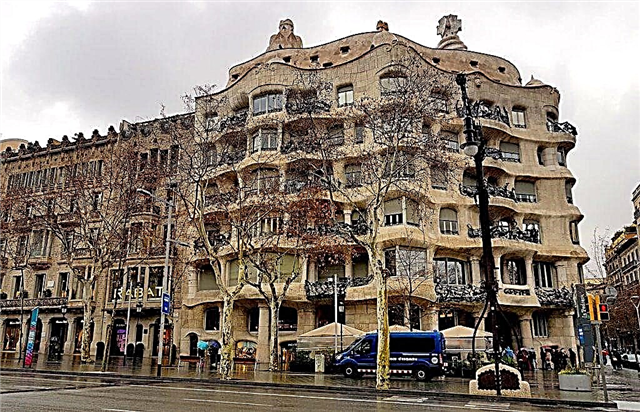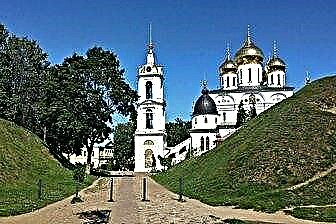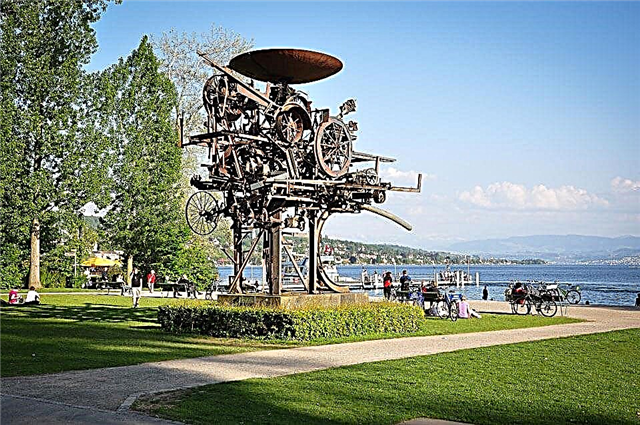Park Guell in Barcelona is one of the most mesmerizing holiday destinations in the world. It is located in the northern part of the port city on an area of 17.18 hectares. The ornate gingerbread houses, the colorful main staircase and the mosaic lizard, designed by Antoni Gaudí, seem to be part of a fairy tale. Walking along the picturesque groves of pines and palm alleys, admiring the inimitable creations of the genius of Catalan architecture, you will immerse yourself in a world where architectural masterpieces coexist with nature in complete harmony.
History of creation

The creation of Park Guell is the result of a business and friendly relationship between Antoni Gaudí and the textile magnate Eusebi Guell, the main sponsor of this project. Their acquaintance began with the Paris World Fair. The stand, where the Spanish architect presented samples of glass and ceramic products, impressed the businessman so much that he met with Gaudí and soon afterwards began to financially support the Catalan artist.
The starting point for the creation of Park Güell was 1900. It was then that the industrialist acquired a plot of land of 15 hectares on a deserted hillside with a fantastic view of Barcelona. The idea of Guell, who returned from Foggy Albion at the beginning of the 20th century, was to create a garden city in the then fashionable English style of an ecological residential zone. The patron has planned the construction of 62 private villas surrounded by green alleys. According to a prearranged contract, future homeowners were not allowed to cut down trees with trunks exceeding six inches.

In 1901, hired land surveyors began to divide the park's territory into plots, and Gaudí took up the preparation of the architectural concept. The second phase of construction included the formation of roads and the construction of three mansions. Between 1910 and 1913 a central entrance with unique pavilions, a curved bench and the "100 Columns" Hall appeared. Unfortunately, 1914 marked the end of construction and the collapse of the project. The idea of a "green paradise" failed miserably.
Wealthy townspeople did not line up for homes in a manor house on the outskirts of Barcelona. Even three wonderful cottages, built by that time, did not save the situation. In 1918, Eusebi Güell died, and after 3 years his heirs sold the land to the municipal government of Barcelona. In 1926, the city park was opened to the public.
Gaudí's architecture and imagination

Today in Parc Guell you can admire Gaudí's creations, which characterize the symbiosis of Catalan Art Nouveau and Symbolism. The architect has designed incredibly complex structures, imbued with mythological elements and historical allusions. According to the author's idea, all buildings should be hidden behind a two-meter fortress wall, lined with stones of local rocks and crowned with medallions with the inscription Park Güell.
The uneven landscape of the hill has led to the appearance of winding streets in the park, made in the form of viaducts, and two-level alleys. Compositions, fountains and sculptures carry visitors into the world of mysterious grottoes, wild jungles and fairy-tale creatures. The details of the buildings, which stand out for their unusual shapes and bright colors, are in perfect harmony with the surrounding nature. In the decoration of architectural objects, the author applied the Mudejar style for the last time in his life. Elements of Gothic, Moorish and Renaissance art that characterize it can be seen in tiles, brickwork, window bars and carved plaster.

In designing their masterpieces, Gaudí and his assistant Josep Maria Hujol used unusual materials: broken tiles and waste from ceramic factories. But despite the external fragility, all structures are unusually strong due to the principle of layering applied during construction. So, the tower at the main entrance consists of layers of reinforcement, concrete and brickwork. The artist used this method in the construction of all the objects of the park.
Gingerbread houses

The most complete part of Park Güell is located at the main entrance. Visitors are greeted by two extraordinary houses that immerse them in a world of fantasy and fairy tales. They say that Gaudí got the idea for their creation from the opera "Hansel and Gretel" by the German composer Humperdinck. Trencadis, a special technique of mosaic finishing, the essence of which is the use of small pieces of broken ceramic tiles, gives the buildings the look of gingerbread cakes covered with a layer of glaze.
Despite the fact that the houses differ from each other, they are designed in the same style, which manifests itself in streamlined shapes, curved roofs, absence of right angles and finishing with raw stone. The carved domes crowning the buildings look like mushroom caps decorated with specks. Taking a closer look, you will understand that these dots are nothing more than images of cups - symbols with which Gaudi indicated his desire to give up coffee.
It was assumed that the administration of the park would be located in one of the outlandish huts, whose white-blue tower is decorated with a cross, and the doorkeeper would live in another, larger one. Today, the service building houses souvenir shops and cafes, and one of the expositions of the city history museum is located in the gatehouse.
Hall "100 Columns"

Just above the gingerbread houses, there is a forked front staircase leading to the Hall of a Hundred Columns. At its base there is a fountain-grotto and a snake's head, enclosed in a round medallion. Slightly higher is the emblem of Barcelona - a figure of a salamander, decorated with glass and porcelain mosaics. Climbing the steps, you will come across a Doric hall that has no walls and resembles an ancient Greek temple.
Expanding downward and slightly inclined six-meter columns (by the way, there are only 86 of them) are arranged in a cellular pattern and serve as the basis for the ceiling, trimmed with shards and four shades of colored glass, symbolizing the seasons. The oval roof of the building is also an esplanade, which was originally conceived as a market square. Today, the terrace above the Hall of 100 Columns is the central and most populous place in Park Güell. From here, there are wonderful views of the capital of Catalonia.
Curved bench

But not only the mesmerizing picture of the city spread out below and the opportunity to take a dozen or two photos attract tourists to the roof of the Doric hall. Here, smoothly framing the entire platform, winds a bench made up of individual concrete blocks and faced with ceramic tiles, fragments of clay products and glass bottles. On closer inspection, the abstract pattern turns into magical figures, mysterious drawings and images of the signs of the zodiac.
As conceived by the master, the curving shape of the endless bench helped not only to accommodate more people who wanted to sit down and relax, but also created an intimate atmosphere for one-on-one conversations. Note the immaculate seat recesses that follow the curves of the human back. In order to achieve this effect, the ingenious architect stripped the workers naked and sat them in a still wet solution.
Three mansions that were bought

In total, there are three houses in the failed estate, one of which was bought by a friend of the industrialist and architect, the lawyer M. Trias y Domenech. The project of the building was ordered from the architect Julie Batliavel, and the place for the construction was chosen by Gaudí himself. An elegant white structure with green shutters can be seen if, while on the terrace of the Hall of 100 Columns, turn your back to the city and look to the right. The Triassic property, surrounded by a green lawn, today belongs to his descendants.
The second mansion was acquired by Guell in 1910, creating his residence there. Later, a municipal school was founded in the building. The third four-storey villa, decorated with a pink spire, was bought by Antoni Gaudi and lived there until 1925. The building was designed by his student, Francesc Berenguer.In 1963, Friends of Gaudí opened a museum in the mansion. The collection consists of items belonging to the genius architect: personal items and furniture. Here you can also get acquainted with the sketches of projects that were not destined to come true.
Park Guell today

In 1962, the entire park area received the status of an artistic monument, and after another 7 years - a national treasure. In 1984, Park Güell, like many of the works of the greatest Catalan master, was added to the UNESCO list of cultural property to be protected.
Today the park is the most interesting attraction of Barcelona and a favorite resting place for the townspeople. Here, at the top of a hill, where the air is much cleaner than in other parts of the southern capital of Spain, you can wander along shady paths, listen to birdsong in an alley or hide from the rain in an arched tunnel. Until 2013, anyone could enter the park for free, but a huge influx of tourists (more than 4 million people a year) forced the city authorities to restrict entry and charge a bribe for it. Now about 95% of the park area is available for free access.
Opening hours and ticket prices
The park's opening hours vary depending on the season:
- from 28.10 to 24.03 - from 8:30 to 18:15 (from 17.02 to 19:00)
- from 25.03 to 29.04 and from 27.08 to 27.10 - from 8:00 to 20:30
- from 30.04 to 26.08 - from 8:00 to 21:30
Days off: 01.01, 25.12. and 26.12.
To enter the Monumental Part, which includes gingerbread houses, a curved bench and the Hall of a Hundred Columns, you must purchase a ticket that gives you the right to enter only at the specified time (or within 30 minutes after it). There is a limitation - every half hour, only 400 visitors are allowed to enter, which creates queues at the ticket office. We advise you to order tickets online - in this case, their cost will be less than the base one by 1 euro.
Tariffs:
- adults: € 8.50
- children 7-12 years old: € 6.00
- children 0-6 years old: € 0.00 (subject to free ticket)
- adults over 65 and disabled: € 6.00
Before traveling, check the visit information on the official website www.parkguell.cat.
Where is it located and how to get there

Park Guell is tucked away in the northern part of Barcelona in the Gràcia district. This area of the city has hilly terrain, so it is not easy to get to it. Due to the size and location of the attraction, try to schedule at least half a day to visit. You can get to the park area by public transport:
- Bus: lines 24, 32, H6, 116 to the Travessera de Dalt stop and the Bus Touristic or Barcelona City Tour buses to the Park Guell stop.
- Metro: green line L3:
- Until the stop Lesseps. Continue up the Travessera de Dalt street until you see on the left the street with the difficult to pronounce name Avinguda del Santuari de Sant Josep de la Muntanya. Go up it to the intersection with Carrer d'Ot, from where you can already see the main entrance. The journey will take 15-20 minutes.
- Until the stop Vallcarca. Walk down Av. De Vallcarca is four blocks, then turn left onto Baixada de la Gloria, where there are escalators leading to the side entrance. Travel time is 12-15 minutes.
The exact address of the park is Carrer d'Olot, 13, 08024 Barcelona.











